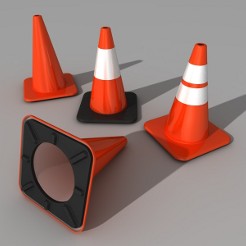
Do you have an upcoming job which will take place at a remote location? Will you be working on or near the street? There are certain guidelines you need to follow when working on or near the street. Depending on the location you may be required to contact the city or state government in advance of the assignment and/or apply for a permit. Even if your job is a quick one which doesn’t require any paperwork, it’s a good idea to be knowledgeable on how to properly setup traffic cones at remote locations.
Setting up cones and other traffic control techniques will protect you and your workers. Traffic cones and drum barricades are utilized on a daily basis simply because they give drivers a heads up about the upcoming work site. It provides a superficial wall between you and incoming traffic.
There isn’t a lot which goes into understanding how to properly setup traffic cones at remote locations. There is, however, a wide variety of cones and barricades you can use for your roadblock. It all depends on the size of your work site as well as how much traffic you need to control. If you work occasionally on the road, it is not a bad idea to own a variety of traffic cones, drum barricades, DIXIE barricades, chain barricades, A-frame traffic control and Type-1 barricades. It’s also not a bad idea to have a handful of barricade lights at your shop (for night work) and traffic signs will allow you to control traffic if certain commands are necessary.
Preparation
Whenever you know you are going to be working on or near the road you should visit the work site as soon as possible. Inspect the area you plan to block off using road cones and make sure you have the proper equipment to carry out the task. How will you navigate traffic while part of the road is blocked off? The goal is to make sure you have enough space to adequately block off your equipment and workers while still allowing traffic to flow naturally, or as naturally as possible.
Equipment
Blocking off the road is not as simple as grabbing a few traffic cones and setting them down. You need to use the proper equipment, just like any job. Shorter cones run in the variety of 18 inches. Shorter cones work in low-volume traffic and are useful in slow speed situations. Larger cones, meanwhile, are usually around 28 inches and because of their bigger frame are picked up by drivers quicker in order to give them more time to react and slow down.
Spacing
Spacing is extremely important when setting up your remote work site. If the cones are spaced too far apart than vehicles will weave in and out of the barricades. The goal is to make the cones smaller than any vehicle, therefore sending a message to traffic that they are to stay in the intended lane and not weave in and out. Also, keep an eye on your cones or barricades throughout the day as there is a tendency for one or two to get knocked over from time to time. While you need space for your work site, make sure the lane of travel is wide enough to accommodate larger vehicles, including semis.
Traffic Control
The general rule is the faster the speed limit the more time you need to take in not only using the proper traffic control equipment, but also spacing. Are two lanes merging into one at high speeds? You’re going to need not only taller cones but more barricades to start from a proper distance in order to prevent car accidents. If you need to merge two lanes at one, 35 mph or higher, angle your cones so the lane which is ending slowly merges into the other.
